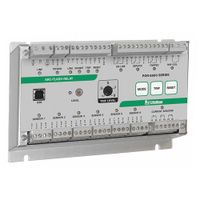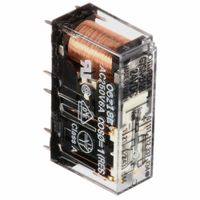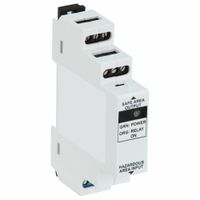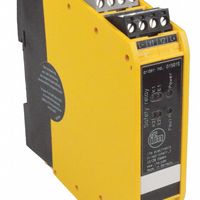Call +(254) 703 030 000 / 751 483 999 / 721 704 777
.....Read More
Frequently Asked Questions
What is the purpose of a safety relay in industrial equipment?
A safety relay is a critical component in industrial equipment designed to ensure the safe operation of machinery and protect both operators and equipment from harm. Its primary purpose is to monitor and control safety functions, ensuring that machines operate within safe parameters and that any potential hazards are mitigated promptly.
Safety relays achieve this by processing input signals from various safety devices, such as emergency stop buttons, light curtains, safety mats, and interlock switches. When these devices detect a fault or unsafe condition, the safety relay quickly interrupts the power supply to the machine, bringing it to a safe state. This rapid response is crucial in preventing accidents and injuries.
Additionally, safety relays are designed to meet stringent safety standards and regulations, such as ISO 13849-1 and IEC 62061, which specify the performance levels and safety integrity levels required for different applications. They often feature redundancy and self-monitoring capabilities to ensure reliability and detect internal faults, further enhancing safety.
In summary, the purpose of a safety relay in industrial equipment is to provide a reliable and efficient means of monitoring and controlling safety functions, ensuring that machinery operates safely and that any potential hazards are addressed immediately to protect both personnel and equipment.
How do safety relays work with safety devices to ensure operator safety?
Safety relays are critical components in industrial safety systems, designed to monitor and control safety devices to ensure operator safety. They function by receiving input signals from safety devices such as emergency stop buttons, light curtains, safety mats, and interlock switches. These devices detect unsafe conditions or operator interventions and send signals to the safety relay.
The safety relay processes these signals to determine if a hazardous condition exists. It uses redundant and diverse internal circuits to cross-check the input signals, ensuring that any fault or failure is detected. If a fault is detected, the safety relay will trigger a safe state, typically by de-energizing its output contacts, which are connected to the machine's control system.
The output contacts of the safety relay are used to control actuators, motors, or other machinery components. When the relay detects a safety breach, it interrupts the power supply to these components, stopping the machine and preventing potential harm to the operator. Safety relays are designed to meet specific safety standards, such as ISO 13849 or IEC 62061, ensuring they provide a reliable safety function.
Safety relays also feature self-monitoring capabilities, regularly checking their own operation and the integrity of connected safety devices. This ensures that any faults in the safety system are quickly identified and addressed. Additionally, safety relays can be configured to handle various safety functions, such as monitoring multiple safety devices simultaneously or implementing time-delayed shutdowns.
In summary, safety relays work with safety devices by continuously monitoring input signals, processing them to detect unsafe conditions, and controlling machine operations to prevent accidents, thereby ensuring operator safety.
What are intrinsically safe relays and where are they used?
Intrinsically safe relays are specialized electrical components designed to prevent ignition in hazardous environments where flammable gases, vapors, or dust may be present. They achieve this by limiting the energy—both electrical and thermal—available in the circuit to levels below what is required to ignite the specific hazardous atmosphere. This is accomplished through careful design and engineering, ensuring that even in the event of a fault, the energy released is insufficient to cause ignition.
These relays are typically used in industries such as oil and gas, chemical processing, mining, and pharmaceuticals, where explosive atmospheres are common. They are crucial in applications involving control systems, sensors, and instrumentation that operate in these environments. By using intrinsically safe relays, companies can ensure compliance with safety standards and regulations, such as those set by the International Electrotechnical Commission (IEC) and the National Electrical Code (NEC).
The relays are part of a broader intrinsically safe system, which includes barriers and isolators that work together to maintain safety. They are often used in conjunction with intrinsically safe barriers, which limit the voltage and current supplied to the hazardous area, and isolators, which provide galvanic isolation between safe and hazardous areas.
Overall, intrinsically safe relays are a critical component in ensuring the safety and reliability of electrical systems in hazardous locations, protecting both personnel and equipment from the risks associated with explosive atmospheres.
How do force-guided relays prevent failures in machinery?
Force-guided relays, also known as mechanically linked relays, are designed to enhance safety and reliability in machinery by ensuring that the contacts within the relay operate in a synchronized manner. These relays have a mechanical connection between the normally open (NO) and normally closed (NC) contacts, ensuring that if one set of contacts becomes welded or stuck, the other set cannot move independently. This mechanical linkage prevents contradictory states, such as both sets of contacts being closed simultaneously, which could lead to dangerous situations.
In machinery, force-guided relays are crucial for safety circuits, such as emergency stop functions and safety interlocks. They ensure that in the event of a fault, such as a contact welding due to an overload, the relay will not falsely indicate a safe condition. This is because the mechanical linkage will prevent the other contacts from changing state, thereby maintaining the integrity of the safety circuit.
By preventing false signals, force-guided relays help avoid machinery failures that could result from incorrect control signals. They ensure that safety systems can reliably detect and respond to faults, triggering appropriate safety measures like shutting down machinery or activating alarms. This reliability is critical in preventing accidents, equipment damage, and downtime.
Furthermore, force-guided relays facilitate regular testing and maintenance of safety circuits. Their design allows for easy detection of contact failures during routine checks, ensuring that any issues are identified and rectified before they can lead to machinery failure. This proactive approach to maintenance enhances the overall safety and efficiency of industrial operations.
What is an arc-flash relay and how does it protect equipment?
An arc-flash relay is a protective device designed to detect and mitigate the effects of arc-flash incidents in electrical systems. Arc-flashes are dangerous electrical discharges that occur when there is a fault or short circuit, releasing intense heat and light, which can cause severe damage to equipment and pose serious safety risks to personnel.
The arc-flash relay operates by using sensors to detect the intense light and heat produced by an arc-flash. These sensors, often optical or current-based, are strategically placed within electrical panels or switchgear. When an arc-flash is detected, the relay quickly sends a trip signal to circuit breakers or other interrupting devices to isolate the faulted section of the electrical system.
The primary function of an arc-flash relay is to minimize the duration and impact of an arc-flash event. By rapidly disconnecting the power supply, the relay reduces the energy released during the incident, thereby limiting damage to equipment and enhancing safety for personnel. This quick response helps prevent catastrophic failures, reduces downtime, and lowers repair costs.
Additionally, arc-flash relays can be integrated with other protective systems and provide valuable data for analyzing incidents, helping to improve future safety measures and system designs. By ensuring rapid detection and isolation of faults, arc-flash relays play a crucial role in maintaining the reliability and safety of electrical installations.
How do safety relays differ from standard relays?
Safety relays and standard relays differ primarily in their design, functionality, and application, particularly concerning safety-critical systems.
1. **Purpose**: Safety relays are specifically designed to monitor and ensure the safety of machinery and processes. They are used in applications where human safety is a concern, such as emergency stop functions, light curtains, and safety gates. Standard relays, on the other hand, are used for general-purpose switching and control applications without specific safety requirements.
2. **Design and Construction**: Safety relays are built with redundancy and fault tolerance in mind. They often have multiple contacts and circuits to ensure that a failure in one part does not lead to a complete system failure. Standard relays typically have a simpler design with fewer fail-safes.
3. **Fail-Safe Operation**: Safety relays are designed to default to a safe state in the event of a failure. This means they will cut off power or stop a machine if a fault is detected. Standard relays do not have this fail-safe feature and may not respond predictably in the event of a failure.
4. **Self-Monitoring**: Safety relays often include self-monitoring capabilities to detect internal faults and ensure they are functioning correctly. They can perform regular checks and alert operators to any issues. Standard relays lack these self-monitoring features.
5. **Regulatory Compliance**: Safety relays comply with stringent safety standards and regulations, such as ISO 13849 or IEC 61508, which dictate their performance and reliability in safety applications. Standard relays do not need to meet these specific safety standards.
6. **Application**: Safety relays are used in environments where the risk of injury or damage is high, such as in industrial automation and machinery. Standard relays are used in less critical applications, such as lighting control or simple motor operations.
What are the key considerations when selecting a safety relay for a specific application?
When selecting a safety relay for a specific application, consider the following key factors:
1. **Safety Standards Compliance**: Ensure the relay complies with relevant safety standards such as ISO 13849-1, IEC 62061, or IEC 61508, which dictate the required safety performance levels.
2. **Application Requirements**: Identify the specific safety functions needed, such as emergency stop, light curtain monitoring, or two-hand control, and choose a relay that supports these functions.
3. **Performance Level (PL) or Safety Integrity Level (SIL)**: Determine the required PL or SIL for the application, which indicates the level of risk reduction needed. Select a relay that meets or exceeds this requirement.
4. **Number of Safety Inputs and Outputs**: Assess the number of inputs and outputs required for the application. Ensure the relay can accommodate all necessary connections.
5. **Response Time**: Consider the relay's response time to ensure it meets the application's safety requirements, especially in high-risk environments where quick response is critical.
6. **Environmental Conditions**: Evaluate the operating environment, including temperature, humidity, and potential exposure to dust or chemicals, and choose a relay with appropriate protection ratings (e.g., IP rating).
7. **Diagnostic Capabilities**: Look for relays with diagnostic features that provide status information and fault detection to facilitate maintenance and troubleshooting.
8. **Integration and Compatibility**: Ensure the relay is compatible with existing control systems and can be easily integrated into the current setup.
9. **Size and Mounting**: Consider the physical size and mounting options to ensure the relay fits within the available space and can be securely installed.
10. **Cost and Availability**: Balance the cost against the required features and ensure the relay is readily available for timely implementation.
11. **Manufacturer Support and Documentation**: Choose a relay from a reputable manufacturer that offers comprehensive support and documentation for installation and operation.



